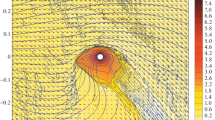Abstract
The influence of the dipolar magnetic field of a “hot Jupiter” with the parameters of the object WASP-12b on the mass-loss rate from its atmosphere is investigated. The results of three-dimensional gas-dynamical and magnetohydrodynamical computations show that the presence of a magnetic moment with a strength of ~0.1 the magnetic moment of Jupiter leads to appreciable variations of the matter flow structure. For example, in the case of the exoplanet WASP-12b with its specified set of atmospheric parameters, the stream from the vicinity of the Lagrange point L1 is not stopped by the dynamical pressure of the stellar wind, and the envelope remains open. Including the effect of the magnetic field leads to a variation in this picture—the atmosphere becomes quasi-closed, with a characteristic size of order 14 planetary radii, which, in turn, substantially decreases the mass-loss rate by the exoplanet atmosphere (by~70%). This reduction of the mass-loss rate due to the influence of the magnetic fieldmakes it possible for exoplanets to form closed and quasi-closed envelopes in the presence of more strongly overflowing Roche lobes than is possible without a magnetic field.
Similar content being viewed by others
References
D. Lai, C. Helling, and E. P. J. van den Heuvel, Astrophys. J. 721, 923 (2010).
S.-L. Li, N. Miller, D. N. C. Lin, and J. J. Fortney, Nature 463, 1054 (2010).
A. Vidal-Madjar, A. Lecavelier des Etangs, J.-M. Dé-sert, G. E. Ballester, et al., Nature 422, 143 (2003).
A. Vidal-Madjar, A. Lecavelier des Etangs, J.-M. Dé-sert, G. E. Ballester, et al., Astrophys. J. 676, L57 (2008).
L. Ben-Jaffel, Astrophys. J. 671, L61 (2007).
A. Vidal-Madjar, J.-M. Désert, A. Lecavelier des Etangs, G. Hébrard, et al., Astrophys. J. 604, L69 (2004).
L. Ben-Jaffel and S. Sona Hosseini, Astrophys. J. 709, 1284 (2010).
J. L. Linsky, H. Yang, K. France, C. S. Froning, et al., Astrophys. J.. 717, 1291 (2010).
L. Fossati, C. A. Haswell, C. S. Froning, L. Hebb, et al., Astrophys. J. 714, L222 (2010).
J. D. Nichols, G. A. Wynn, M. Goad, R. D. Alexander, et al., Astrophys. J. 803, 9 (2015).
R. V. Yelle, Icarus 170, 167 (2004).
A. GarcíaMuñoz, Planet. Space Sci. 55, 1426 (2007).
R. A. Murray-Clay, E. I. Chiang, and N. Murray, Astrophys. J. 693, 23 (2009).
T. T. Koskinen, M. J. Harris, R. V. Yelle, and P. Lavvas, Icarus 226, 1678 (2013).
T. T. Koskinen, M. J. Harris, R. V. Yelle, and P. Lavvas, arXiv:1210.1536 [astro-ph.EP] (2012).
D. V. Bisikalo, P. V. Kaygorodov, D. E. Ionov, and V. I. Shematovich, in Characterizing Stellar and Exoplanetary Environments, Ed. by H. Lammer and M. Khodachenko, Astrophys. Space Sci. Lib. 411, 81 (2015).
D. E. Ionov, V. I. Shematovich, and Ya. N. Pavlyuchenkov, Astron. Rep. 61, 387 (2017).
D. Bisikalo, P. Kaygorodov, D. Ionov, V. Shematovich, et al., Astrophys. J. 764, 19 (2013).
D. V. Bisikalo, P. V. Kaigorodov, D. E. Ionov, and V. I. Shematovich, Astron. Rep. 57, 715 (2013).
A. A. Cherenkov, D. V. Bisikalo, and P. V. Kaigorodov, Astron. Rep. 58, 679 (2014).
D. V. Bisikalo, A. A. Cherenkov, and P.V. Kaygorodov, in Solar and Stellar Flares and Their Effects on Planets, IAU Symp. 320, 224 (2016).
D. V. Bisikalo and A. A. Cherenkov, Astron. Rep. 60, 183 (2016).
D. V. Bisikalo, P. V. Kaygorodov, and A. S. Arakcheev, in Living Together: Planets, Host Stars and Binaries, Ed. by S. M. Rucinski, G. Torres, and M. Zejda, ASP Conf. Ser. 496, 337 (2015).
A. P. Showman and T. Guillot, Astron. Astrophys. 385, 166 (2002).
D. J. Stevenson, Rep. Prog. Phys. 46, 555 (1983).
J.-M. Grießmeier, A. Stadelmann, T. Penz, H. Lammer, et al., Astron. Astrophys. 425, 753 (2004).
A. Sańchez-Lavega, Astrophys. J. 609, L87 (2004).
K. G. Kislyakova, M. Holmström, H. Lammer, P. Odert, et al., Science 346, 981 (2014).
T. T. Koskinen, J. Y.-K. Cho, N. Achilleos, and A. D. Aylward, Astrophys. J. 722, 178 (2010).
G. B. Trammell, P. Arras, and Z.-Y. Li, Astrophys. J. 728, 152 (2011).
I. F. Shaikhislamov, M. L. Khodachenko, Y. L. Sasunov, H. Lammer, et al., Astrophys. J. 795, 132 (2014).
M. L. Khodachenko, I. F. Shaikhislamov, H. Lammer, and P. A. Prokopov, Astrophys. J. 813, 50 (2015).
G. B. Trammell, Z.-Y. Li, and P. Arras, Astrophys. J. 788, 161 (2014).
T.Matsakos, A. Uribe, and A. Königl, Astron. Astrophys. 578, A6 (2015).
S. K. Godunov, Mat. Sb. 447, 271 (1959).
D. V. Bisikalo, A. G. Zhilkin, and A. A. Boyarchuk, Gas Dynamics of Close Binary Stars (Fizmatlit, Moscow, 2013) [in Russian].
A. A. Harten, J. Comp. Phys. 49, 357 (1983).
T. Chan, M. Ingemyr, J. N. Winn, M. J. Holman, et al., Astron. J. 141, 179 (2011).
G. L. Withbroe, Astrophys. J. 325, 442 (1988).
J. E. Owen and F. C. Adams, Mon. Not. R. Astron. Soc. 444, 3761 (2014).
Author information
Authors and Affiliations
Corresponding author
Additional information
Original Russian Text © A.S. Arakcheev, A.G. Zhilkin, P.V. Kaigorodov, D.V. Bisikalo, A.G. Kosovichev, 2017, published in Astronomicheskii Zhurnal, 2017, Vol. 94, No. 11, pp. 927–937.
Rights and permissions
About this article
Cite this article
Arakcheev, A.S., Zhilkin, A.G., Kaigorodov, P.V. et al. Reduction of mass loss by the hot Jupiter WASP-12b due to its magnetic field. Astron. Rep. 61, 932–941 (2017). https://doi.org/10.1134/S1063772917110014
Received:
Accepted:
Published:
Issue Date:
DOI: https://doi.org/10.1134/S1063772917110014



